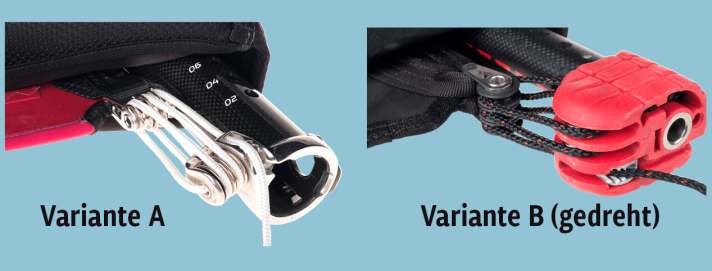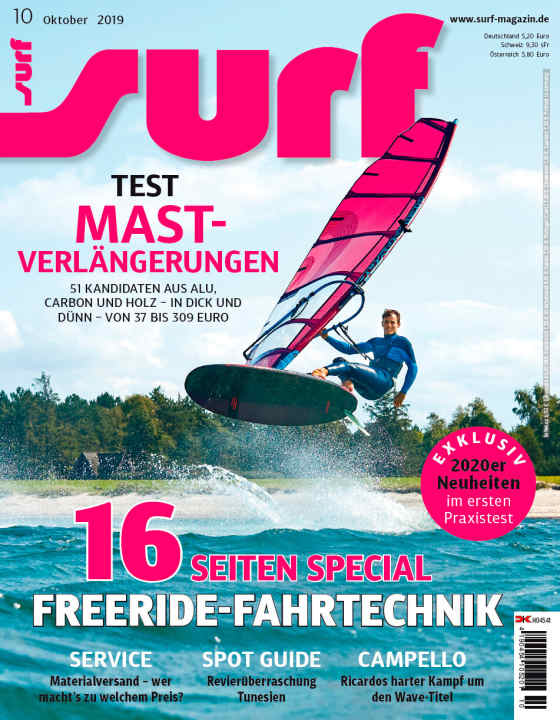Test 2019/2020: 51 extensions in a big comparison

Even an extension for 39 euros does what it is supposed to do, namely extend the mast. In addition, a lot has changed in the last few years, even with extensions. Better pulley arrangements make it possible to thread all types of sails (with normal or twisted pulley blocks). These include larger pulleys and clamps that have been moved further outwards to improve the line of the rope. Metal reinforcements for the inserted base plate further increase the already good life expectancy, and adjustment rings with a joint are easy to operate with one hand. Compared to the most modern cups, some older models look quite old. However, those who are not dependent on optimum compatibility with both sail variants, for example, can certainly find a bargain that works really well for "their" sail. And for more sophisticated requirements, there is a really perfect counterpart for every sail.
RDM and SDM
Whenever "RDM" and "SDM" appear in the test - and elsewhere - they either mean masts and extensions with the decades-old standard of 48 millimetres inside diameter (SDM = standard diameter mast) or the thinner masts with 32 millimetres inside diameter (RDM = reduced diameter mast), which are actually the new standard, at least for sail sizes under 6.0 square metres.
Equipment
Practical snap rings and stainless steel fittings are useful features - but greater robustness and ease of use are also reflected in the price. Many more expensive models now come with smooth, low-friction Dyneema ropes. Ascan and GunSails have to make do without their own ropes.
Better threading
Many extensions are optimised for the more common type A sails (see below). To ensure that this is not only low-friction but also logically easy to thread, more and more extensions are appearing in which the pulley axis is rotated by 90 degrees and is now parallel to the pulley axis on the sail (NeilPryde, Unifiber, Al 360 and others). The plastic cup used on Aeron and NeilPryde UXT is suitable for variant B (pulley block rotated on the sail: Naish, Severne), but only if there is air between the sail and the extension can an acceptable rope run be achieved. When trimmed "block on block", the rope runs very diagonally over the plastic edge into the cleat. Extensions where the start of the rope is in the pulley axis (GA, NeilPryde, Point-7) can be converted and threaded particularly quickly and easily for the two different pulley variants on the sail.

You can find the entire test for these 51 extensions, including all test assessments and technical data, as a PDF in the download area below:
- AERON: Skinny U-Pin Alu | Skinny U-Pin Carbon | SDM U-Pin Alu
- AL360RDM Ergal | RDM Wood | RDM Carbon | SDM Ergal QR | SDM Ergal
- ASCANSkinny | Skinny Carbon | SDM Big Wheel | SDM Master
- CHINOOKRDM Aluminium | RDM Carbon | SDM Aluminium | SDM Carbon
- DRAKER+SDM Aluminium | R+SDM Carbon
- DYNAFIBERRDM aluminium | SDM aluminium
- GA SAILSRDM Alu PRO | SDM Alu PRO
- GUNSAILSRDM Classic | RDM Carbon | SDM Classic
- NEILPRYDERDM UXT Alu | RDM MXT Alu | RDM MXT Carbon | SDM UXT Alu | SDM MXT Alu | SDM MXT Carbon
- POINT-7RDM Extension PRO | SDM Extension PRO
- RRDRDM Avant | SDM Avant | SDM Dynamic PRO
- SEVERNERDM Cyclops HD | RDM Triple HD | RDM Wavegrenade HD | RDM Triple Carbon | RDM Cyclops Carbon | RDM Wavegrenade Carbon | SDM HD Race | SDM Carbon Race
- SIDEONRDM aluminium | SDM aluminium
- STREAMLINEDRDM Red Line Alu | RDM Carbon | SDM Red Line Alu
- UNIFIBERRDM Elite | SDM Elite







